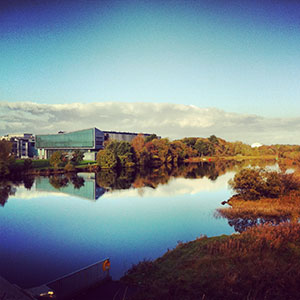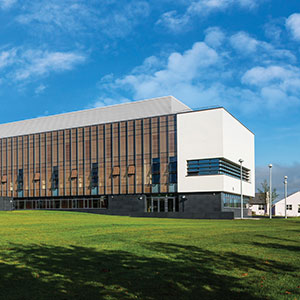-
Courses

Courses
Choosing a course is one of the most important decisions you'll ever make! View our courses and see what our students and lecturers have to say about the courses you are interested in at the links below.
-
University Life

University Life
Each year more than 4,000 choose University of Galway as their University of choice. Find out what life at University of Galway is all about here.
-
About University of Galway

About University of Galway
Since 1845, University of Galway has been sharing the highest quality teaching and research with Ireland and the world. Find out what makes our University so special – from our distinguished history to the latest news and campus developments.
-
Colleges & Schools

Colleges & Schools
University of Galway has earned international recognition as a research-led university with a commitment to top quality teaching across a range of key areas of expertise.
-
Research & Innovation

Research & Innovation
University of Galway’s vibrant research community take on some of the most pressing challenges of our times.
-
Business & Industry

Guiding Breakthrough Research at University of Galway
We explore and facilitate commercial opportunities for the research community at University of Galway, as well as facilitating industry partnership.
-
Alumni & Friends

Alumni & Friends
There are 128,000 University of Galway alumni worldwide. Stay connected to your alumni community! Join our social networks and update your details online.
-
Community Engagement

Community Engagement
At University of Galway, we believe that the best learning takes place when you apply what you learn in a real world context. That's why many of our courses include work placements or community projects.
Redirect
Redirecting web visitors to another web address
You can add a 'Redirect' content type to any section.
This places an instruction on the web page, that this section publishes, to send the visitor to another web page entirely.
Once published, this instruction will run as soon as someone browses to the page, making the visitor's browser automatically load a completely different web page.
Why you might want to use a Redirect
Example 1 - Wrong address published
The 'Redirect' content type is especially useful if the wrong web address was published somewhere.
For example, if an email went out, saying 'For more information, visit www.universityofgalway.ie/coa/' but that link should have ended with '/cao/', everyone following the link would encounter a '404 - Page Not Found' error.
If, for some reason, you could not simply send a correction email, the next best way to resolve this problem would be to:
- Create the (currently non-existent) page that the email is linking to (www.universityofgalway.ie/coa).
(You'd do this by creating a new sub-section of 'University of Galway' and entering the value coa into its 'Output URI' field) - Add a redirect type into this new sub-section.
- Give it a name, such as 'Redirect to CAO page', so that future CMS editors will understand what this content does without having to open it.
- Enter the web address that you want the page visitor to be automatically brought to.
In this example's case, you'd enter htttps://www.universityofgalway.ie/cao/ - Save and approve
Now that the section contains some approved content, it will publish to the web server whenever the next scheduled publish runs. Scheduled publshes normally begin at the stroke of every hour, so by half past the hour, your new /coa page should be live on the University website.
From that point forward, whenever anyone clicks on the email's link, they will no longer encounter a '404 - Page not found' error. Instead, your new webpage will load for them. As soon as this web-page loads, its Redirect will kick in and the visitor's browser will automatically go to the correct webpage (universityofgalway.ie/cao).
Example 2 - Shortcuts
Redirects were employed to create short web addresses for courses.
For example, a section was created that publishes to www.universityofgalway.ie/gy101 - it contains a Redirect to the longer web address https://www.universityofgalway.ie/courses/undergraduate-courses/arts.html, making it far easier for prospective students to browse to the course page they are interested in.
This technique was used to create shortcuts to all undergraduate courses, using their CAO codes.
Instructions: How to Add a Redirect to a page
- Edit the section you want to add the redirect to.
- Add a 'Redirect' content type to this section.
(It doesn't matter if there is other content in this section already - the Redirect will still work)- Give it a descriptive name. E.g. 'Redirect to UG Courses Page'
- Enter the full web address of the page you want to automatically bring the user to, whenever they load this page.
E.g. https://www.universityofgalway.ie/courses/ - 'Save and approve'
- 'Save Changes' and then wait for the webpage, that your modified section controls, to publish.
This will usually be completed by half past the next hour (so if you do this at 15:04, the modified webpage usually will be live by 16:30)
Example
Below is a link to an example of a Redirect in action. This link goes to the page www.universityofgalway.ie/t4/examples/redirect/example/ but as soon as it loads, it will Redirect you back to this page (which will auto-scroll to the Extra Information you probably haven't read yet).
Things you need to know about Redirects
Redirects always work ...
It's possible to have other content on a page that contains a Redirect content type.
However, it will not disrupt the redirect from happening. The page (with all its content) will load, and once it has finished loading, the redirection code will kick in, instructing the visitor's browser to immediately go to another page entirely.
This happens so quickly, you won't get a chance to read the content that was on the page.
... Unless JavaScript is disabled
If you are using a browser that disables JavaScript, the Redirect will not work. All common browsers execute JavaScript (JS) code automatically, which is why Redirects work for all visitors - but it's possible to tell that browser not to run JS, in which case, you'd be able to read all the content on the page because the browser will ignore the instruction to go to another web address.
While it is very rare for a person to use a browser that ignores JS, there are some things that ALWAYS ignore JS - Search Engines.
Redirecting users away from out-of-date content
If you decide the content on a page is out of date, and you'd prefer your visitors to go to another page, where there is more up-to-date info, you may decide to add a Redirect to your page because this will automatically move your page visitors on to the authoritative webpage.
This approach will work perfectly for humans browsing your site - but search engines will still see the text that is on your page (that the humans won't get a chance to see, before the Redirect kicks in and another page loads). And these search engines will happily regurgitate the out-of-date info they read on your page.
This is becoming more of a problem with the rise in popularity of AI searches, which try to give you the answer to your question without you needing to click on any of your search results. It's also affects the quality of information people may receive via voice searches.
E.g. 'Hey Siri, How much does a degree in arts cost in Galway?'
'Alexa, what's the closing date for applications for Arts in the University of Galway?'
So, if you are using a Redirect on a page, it is best to delete (or expire) the rest of the content on the page, so that your old content doesn't get reported to someone as fact.















